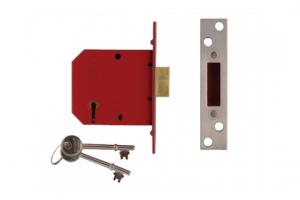Mortice Locks
Are you looking to install new locks on your doors to enhance your security system? If so, then you must consider mortice locks. They are one of the most common and effective locks out there. And this is why many insurance policies specifically require that you install a British Standard BS3621 mortice lock.
What are mortice locks?
A mortice lock, by definition, is a kind of locking mechanism which requires cutting a pocket into the door in order for the lock to be installed. The pocket or the space in the door to install the lock is known as a mortice. And this is where the lock derives its name from. Mortice locks are a popular choice for many residential and commercial users due to their resilience and reliability.
How do they function?
The basic functioning mechanism of mortice locks is simple enough to understand. The lock consists of a deadbolt and a lever mechanism. The set of levers prevent the bolt from moving. When a key is inserted in the lock, it straightens the levers and creates a slot which allows the bolt to slide in order to lock or unlock the door.
The level of security a mortice lock can provide depends on its quality and the number of levers it has. The levers are usually present in an odd number so that the same key can be used to unlock the doors from both sides. Usually, the two most common classifications of the mortice lock are based on the number of levers it has. This includes:
3-lever lock: As the name suggests, the 3-lever lock has three internal levers to unlock the door. Since it is relatively easier to open, the 3-lever lock is used on low-security applications, like internal doors. There are fewer key combinations available for the 3-lever locks so it might be dangerous to install them on the front door since many keys would have the ability to unlock the door.
5-lever lock: When we talk about British Standard BS3621 mortice locks, we are usually referring to a 5-lever lock. Many homeowners are required to install 5-lever locks, by their insurance companies, to ensure enhanced security. The five internal levers make it difficult for criminals to pick the lock using traditional means while the wide range of available keys reduces the chances of other keys opening the door.
Which doors require the mortice locks?
Since the mortice locks require a pocket or a mortice for installation, they can be only fitted in wooden doors, whether it is a solid wooden door or a glass-plated wooden door. You cannot install a mortice lock on a UPVC door. For that, you would require a Euro lock mechanism.
The size of a British Standard mortice lock may differ depending on the door in which the lock is installed. For instance, smaller size British Standard locks are installed in internal doors whereas the large size BS3621 locks are used in entrance doors.
The different kinds of mortice locks
When you’re out shopping for mortice locks, here are the two types you need to consider:
Mortice deadlock: The deadlock contains only one key-operated bolt used to lock the door. You may pair it with a separate latch mechanism. The mortice deadlocks are used on doors which need to be opened and closed without being locked. It is simple and convenient.
Mortice sash lock: The sash locks combine a deadbolt and a latch in a single mortice box. This way, the door is on latch whenever it is closed and can be further locked for additional security. It is ideal for multipurpose usage.
The advantages of Mortice locks
You may consider installing Mortice locks because:
- The mortice box in a British Standard lock is composed of anti-drill plating.
- The deadbolt consists of hardened steel spindles to prevent cutting.
- They are difficult to penetrate because of how they’re installed.



Categories: Uncategorized